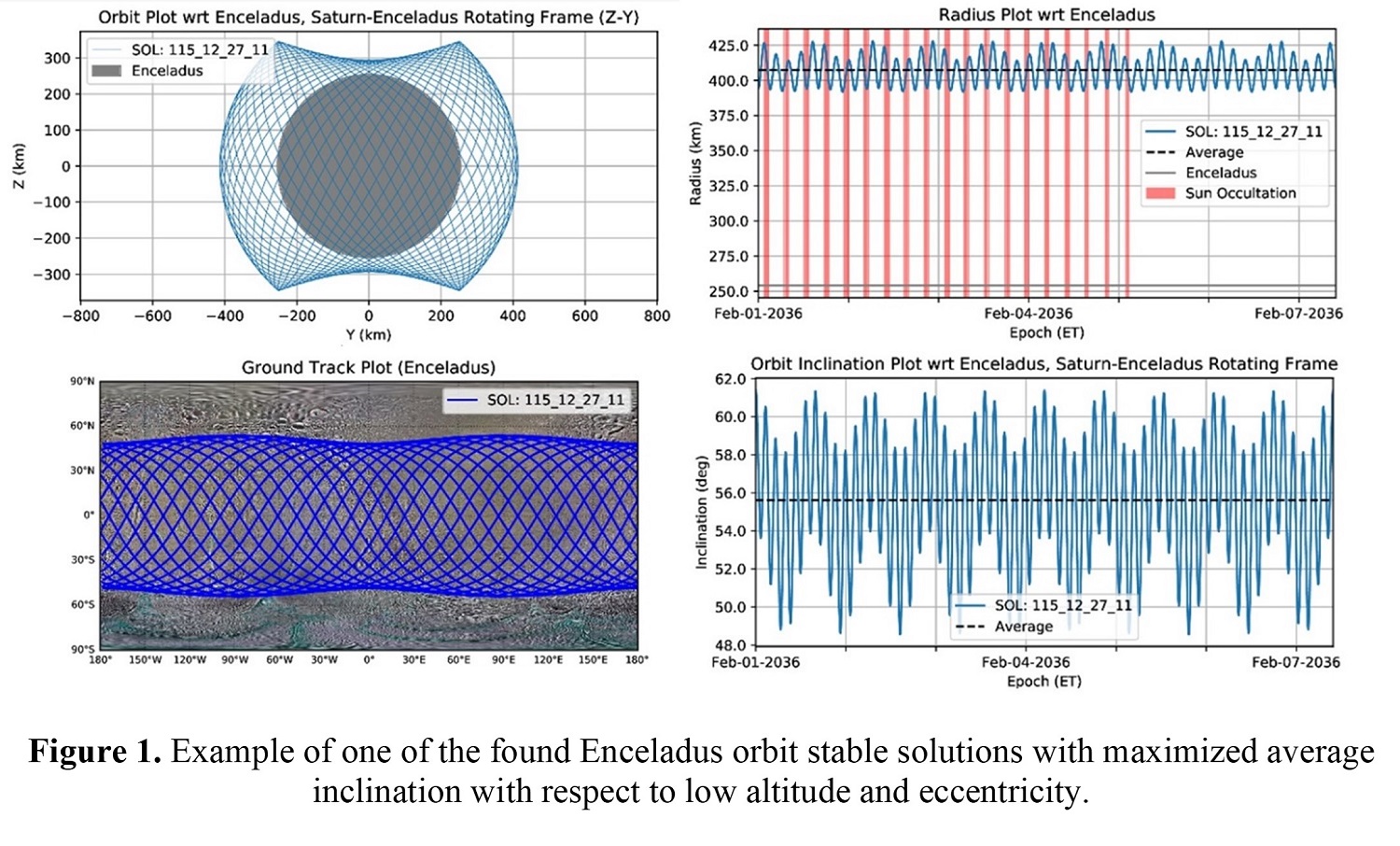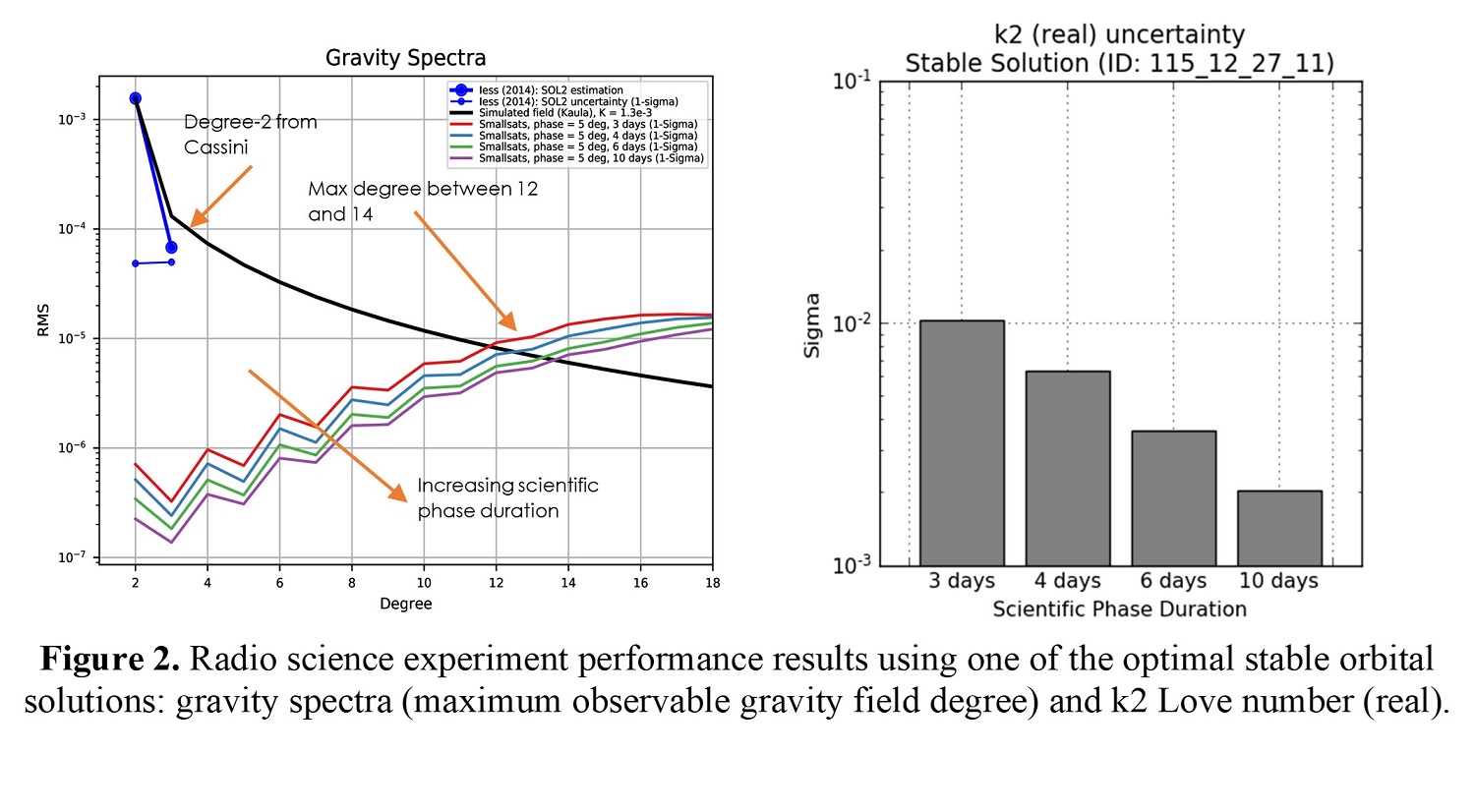Enceladus Gravity Investigation using a SmallSat Mission
- 1Department of Industrial Engineering, Alma Mater Studiorum - Università di Bologna, Italy
- 2Centro Interdipartimentale di Ricerca Industriale Aerospaziale, Alma Mater Studiorum - Università di Bologna, Italy
ABSTRACT
Enceladus is a Saturn’s icy moon that possesses a sub-surface ocean and a complex geological activity, with implications for its potential habitability. Gravity investigations at Enceladus could provide information on its internal structure including the radial density distribution, gravity anomalies, ice shell thickness and properties of the sub-surface ocean (mean density). In the recent years it was proposed to use SmallSat companion missions, dedicated only to specific investigations, to complement the science observations of a traditional larger exploration spacecraft. This represents a promising option since SmallSats provide relatively low-cost and versatile platforms for scientific observations. To investigate Enceladus’ gravity a SmallSats companion mission is proposed. The mission concept foresees two SmallSats deployed in orbit around Enceladus by a main Saturn’s orbiter. The objective is to globally characterize Enceladus’ gravity field through radio science investigations based on the Satellite-to-Satellite Tracking (SST). The observables are generated and decimated on-board by the SmallSats and transmitted back to Earth for data analysis and gravity field reconstruction, using the main spacecraft as a relay. However, Saturn proximity to Enceladus lead to major orbital instabilities for scientific near polar orbits. Moreover, the great distance from the Sun is a major drawback for the SmallSats platforms. Therefore, a mission feasibility study has been conducted by analyzing three-body stable orbits, proposing different SmallSats system budgets and concept of operations, and finally, by performing a radio science experiment performance preliminary assessment.
ORBITAL ANALYSIS
Due to the third body perturbation exerted by Saturn, near polar orbits are then highly unstable with a characteristic impact times up to 3 days [1]. Therefore, even if such orbits are optimal for scientific observations, they are too risky to be considered in this case. Periodic stable solutions are then searched by studying the Circular Restricted Three Body Problem (CRTBP) based on Saturn, Enceladus and one SmallSat. The research was mainly focused on 3D long period stable solutions with maximized inclination to improve the gravity science experiment performance. The search algorithm is based on a dedicated differential corrector [2] and the stability of the solution is evaluated through an index equal to the maximum of the eigenvalues of the monodromy matrix. The preliminary research has found 207505 periodic stable solutions from a search grid of 8000000 initial conditions (with minimum altitude above Enceladus set to 50km for planetary protection purpose). Currently, no stable solutions have found with average inclination greater than 75 degrees, in accordance with other studies [2][3]. Moreover, it has been seen that stable solutions with lower altitude tends to have a smaller average inclination. An example of a potential optimal solution (chosen from a tradeoff between eccentricity, altitude, and inclination) is represented in Figure 1.

SYSTEM ANALYSIS
Two different mission concepts have been analyzed, both consisting of two 12U CubeSats performing SST while orbiting Enceladus. In the first mission concept, the feasibility of a short mission employing CubeSats relying solely on battery cells stored energy is explored. The second concept evaluates equipping the CubeSats with solar arrays to extend the mission duration. Since the solar flux at Enceladus is 100 times smaller than the one experienced in Earth orbit, the expected solar panels power output is so low that, in this latter concept, scientific observation phases needs to be alternated to CubeSats hibernation phases in which batteries are recharged. The SST payload features an S-band transceiver, two monopole antennas for RX/TX scientific operations and an S-band patch antenna coupled with an HPA for data relay to mothercraft. The raw data are preprocessed on board. The expected scientific data output is in the order of 300 kb/day accounting for ranging and doppler measurements. Due to strict planetary protection requirements, the two CubeSats are equipped with a camera for autonomous Optical Navigation and a green chemical hybrid propulsion system for station-keeping, orbital disposal and momentum unloading. Environment related constraints, as thermal control management and radiation environment are also evaluated and addressed.
RADIO SCIENCE EXPERIMENT PERFORMANCE
Orbital stability and system analysis provided solutions have been then injected to the radio science experiment performance preliminary assessment. The expected performances of the gravity field reconstruction were evaluated through multi-arc numerical simulations, using realistic assumptions on the noise level. The dynamical model is based on gravitation accelerations of all planets and Saturn’s satellites plus the Enceladus extended gravity field 50x50 simulated with Kaula’s Rule (K=1.3E-3)[4], and the Solar Radiation Pressure (SRP). The simulated measurements are Two-way S/S Doppler measurements between the SmallSats. The angular separation between the SmallSats has been set to 5 degrees, as it was found that higher angles are less effective for the experiment performance. Simulations results show the scientific phase duration to be the main performance driver for the experiment. Therefore, a comparison of the different scientific phase durations has been conducted (potential durations have been provided by the system budget analysis). An example of the results of the radio science experiment performance assessment for the stable solution of Figure 1 are presented in Figure 2. In the gravity spectra plot, the black line identifies the simulated gravity field, therefore when an uncertainty line goes above it then the maximum observable degree is depicted.

REFERENCES
- Russel, M. Lara, “On the Design of an Enceladus Science Orbit”, AIAA 2008-7072, 28 August 2008.
- Russel, “Global Search for Planar and Three-Dimensional Periodic Orbits Near Europa”, The Journal of the Astronautical Sciences, Vol. 54, No. 2, April–June 2006, pp. 199–226.
- S. Parker, R. L. Anderson, “LOW-ENERGY LUNAR TRAJECTORY DESIGN”, JPL, California, July 2013.
- Kaula, W, M., “Theory of Satellite Geodesy”, Blaisdell, Waltham, 1966.
How to cite: Lombardo, M., Strollo, E., Locarini, A., Lasagni Manghi, R., Modenini, D., Tortora, P., and Zannoni, M.: Enceladus Gravity Investigation using a SmallSat Mission, European Planetary Science Congress 2021, online, 13–24 Sep 2021, EPSC2021-780, https://doi.org/10.5194/epsc2021-780, 2021.

